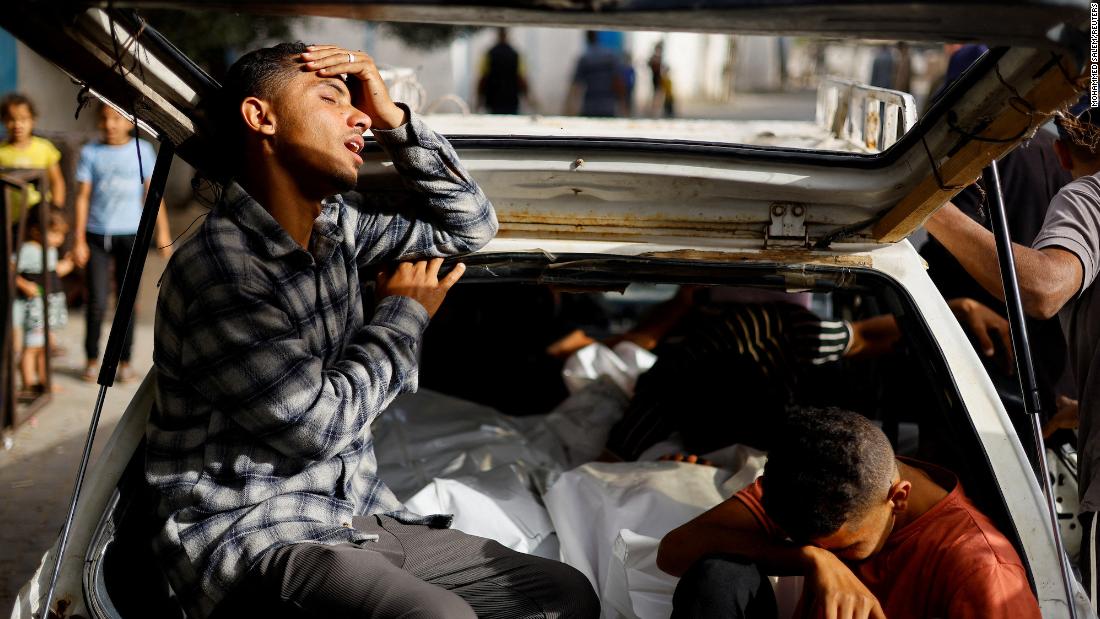A day after the government shutdown ended, a ranger walked along a trail in Joshua Tree National Park, bathed in golden light.
It was his first day back and he had just walked through a sea of scorched Joshua trees rising from the blackened earth, their dagger-shaped leaves stained a sickly yellow.
It was one of the places in the park where the trees are supposed to live, even in 100 years, the ranger said, when most places in the park will not be suitable for Joshua trees.
“So, seeing those who should be the parents of the next generation…” he said, his voice breaking. He spoke anonymously for fear of reprisals.
Fire retardant was dumped to help extinguish the Black Rock Fire, which covered many plants, including this Beavertail Cactus.
This was “a nightmare scenario,” said a park firefighter, who also spoke on condition of anonymity for fear of retaliation. During the last government shutdown six years ago, the revelation that vandals appeared to have cut down some of the trees Dr. Seuss-style made national headlines. In this case, firefighters estimate that more than a thousand trees were burned. Brendan Cummings, conservation director at the Center for Biological Diversity, also examined plants in the burned area and came to a similar estimate.
The area, not far from Black Rock Campground, is one of the densest Joshua tree forests in the park. Located at a higher elevation, it is considered a climate refuge for the iconic trees, which are threatened by the hot, dry conditions found below.
According to the firefighter, the fire started last month when a park visitor set his toilet paper on fire. Firefighters quickly stopped it at 72 acres, but many trees had already been burned.
It was a “totally avoidable tragedy,” he said. Rangers who could have provided important fire safety education were not working as a result of the closure, he said.
Interior Department spokeswoman Elizabeth Peace said the cause of the fire remains under investigation.

One of many damaged Joshua trees dotting the landscape in the Black Rock Fire scar.
Looking ahead, “normally we would try to…restore that critical habitat that we've lost,” the firefighter said. But even with the government reopening, he said operations remain hampered by personnel losses that disproportionately affect conservation and restoration, including saving Joshua trees and desert tortoises. “So we're going to have to do less. We can't do as much to save the trees.”
The park's resources division once had 30 employees, he said, and is now down to six full-time employees and one part-time employee. About a third of the team has left since Trump came to the White House for the second time, amid pressured retirements that hit the entire park service, he said.
The Interior's Peace said the resource team was never comprised of 30 full-time employees and that contractors also help carry out the work.
According to the National Park Conservation Association, the park service has lost nearly a quarter of its permanent staff since January. The Trump administration believes the federal workforce has grown too large.
The firefighter estimates that between 15 and 30% of the trees damaged in the Black Rock fire will resprout and develop new stems from their root systems. It is a chance for a new life, but many do not survive. Hares or other critters that need the water locked in the plant often swallow them. A good way to protect them is quite basic: place protective cages.
There may be little or no restoration active.
“Park leaders determined that the scale and impacts of the fire did not warrant a large-scale restoration effort,” Peace said in a statement, adding that the park service must balance priorities.
No action is being seriously considered, the firefighter said. In that case, sources said, most of the Joshua tree's new growth would come from seeds brought to the burned area by seed dispersers such as antelope squirrels. Joshua trees grown from seed can take 50 to 70 years to reproduce.

Brendan Cummings, conservation director at the Center for Biological Diversity, walks across the ashy ground at the burn scar.
Cummings of the Center for Biological Diversity, which petitioned to list the Joshua tree under California's Endangered Species Act, said a generally hands-off approach would not bode well for the iconic trees. But what he described as a lack of funding for the park service, plus a proposed $1 billion budget cut, could force tough decisions.
“In the era of climate change, Joshua trees will not survive in Joshua Tree National Park without active management,” Cummings said.
That includes replanting them in burned areas and perhaps watering them, he said.
Doing what is necessary “to ensure that the species has the best chance of surviving in the difficult decades ahead” should be [officials’] The number one priority,” he said, since the plant is inscribed in the park's name. “But they also have the mandate to operate campgrounds and keep the roads running and things like that.”
In his statement, Peace said active management of trees is important to their persistence, “which is why the superintendent balances those [resource management] priorities.”
The trees, which are actually succulents, are protected by a special state conservation law and are candidates for California's threatened species list.

Baby Joshua trees, along with other plants commonly found in Joshua Tree National Park, are growing in an outdoor nursery at the Mojave Desert Land Trust. The conservation nonprofit plans to transfer the plants to the park next fall, where they will be used to restore damaged areas.
Environmentalists see fire as an existential threat to trees. Fires were once rare in the Mojave Desert, but have become increasingly common amid warmer, drier conditions and more extreme changes in precipitation.
Invasive species such as red brome and Mediterranean grass are also driving the increase.
As he walked toward the recently burned area, Cummings pointed out a young Joshua tree smothered in dry grass. “The grass can carry the fire to the tree,” he said. Thirty years ago, the earth around the tree would have been practically bare.
It's not all pessimism. The recent fire could have been much larger and more ferocious. It is not yet known how many of the trees he burned will die. Green leaves are visible on the pinecone-like crowns of many of them, although plant experts said that doesn't mean they will make it.
And not far from the park, an army of trees is being grown as a kind of insurance policy against such calamities. In June, the Mojave Desert Land Trust, a nonprofit conservation organization, partnered with Joshua Tree to grow more than 3,000 plants of 29 common species, including hundreds of Joshua trees, from seeds collected in the park. The plan is to move them to the park next fall.
The park has a small nursery of its own, but after facing significant damage from large fires in recent years, officials want an arsenal of plants to respond efficiently, said Patrick Emblidge, the land trust's plant conservation program manager. In the Mojave, he added, restoration is more successful if plants suitable for specific areas of the park are used and the response is quick.

As dusk falls, Patrick Emblidge of the Mojave Desert Land Trust tends to young desert plants, including Joshua trees, which are just a few inches tall.
“The desert is thought to be pretty sparse, but I think the natural plant density in the desert is about 3,000 plants per acre, and these fires cover hundreds of acres,” he said. “So to get back to that natural ecosystem, to that vegetative structure, you really need a lot of plants.”
Emblidge described the Black Rock fire as “exactly why we're doing this project.”
It will be a long time before the little Joshua trees look like the twisted icons that dot the park. Those planted in August are currently just small greenish-blue sprouts. By the time they are delivered next year, Emblidge expects them to be about six inches tall. The six-year-old trees in the nursery looked like pointed pineapple tops.

One of many desert plants being grown at the Mojave Desert Land Trust for future restoration work in nearby Joshua Tree National Park.
Last week, many of the seedlings were placed in rows in plastic containers in the land trust's outdoor nursery. In the midst of an increasingly dim light, the delicate fledglings fluttered in a wind that presaged a storm.












